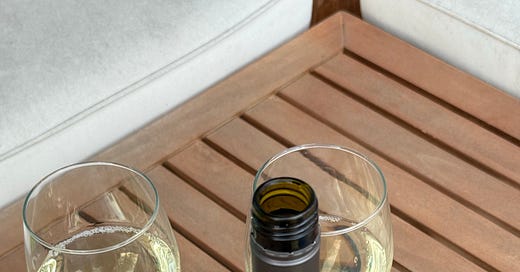Oxygen is essential—and detrimental—to a wine. How confusing.
There are a lot of choices that go into the winemaking process and define producers for their unique styles. Grape varieties, yeast strains (or using ambient/wild yeast), how much skin contact the grapes have during fermentation, what the wine ferments and ages in…and of course, oxygen exposure.
I’m not going to dive into all of the scientific jargon when it comes to oxygen during the fermentation process because there’s…a lot of it. I’ll keep it simple: when the must (aka grapes with skins and stems) is exposed to oxygen as it macerates and ferments, the contact with the yeast helps to reduce astringency (tannins), deepens the color of a wine, and gives it a bigger mouthfeel. This is typically a practice used for some reds, fortified wines, and you might even see it for orange wines or white wines that have longer skin contact.
However, too much exposure to oxygen after the fermentation process will rapidly age the wine and will cause it to go bad. This is in fact what is happening when you open that bottle of wine at home, or even swirl it in the glass. You’re releasing all of those aromas by exposing it to oxygen, and aging the wine. While oxygen exposure can be good for the wine-drinking experience, “too much of a good thing” can be true if the wine is exposed for too long. Once open and exposed to air, your wine will go bad in less than a week.
We know now that storing the cork upside down in the bottle is not the answer (hello, potential mold), so what is? The answer is storing it properly, and with as little oxygen exposure as possible.
How to seal the bottle after opening
Sealed reusable stoppers
An easy solution is to find some kind of tight-sealed reusable top for easy storage. This is a great if you plan on finishing up that wine over the next couple of days. I have a couple of glass bottle stoppers that seal and keep the wine covered, then the wine goes in the fridge. (You can also fine sparkling wine stoppers that seal well.) Again, drink it within a couple days. There’s still air exposure inside the bottle, even if it’s a very small amount of it.
Mason jars
Instead of keeping wine in the bottle, you could transfer it to a mason jar (or a similar carafe) where the wine will be exposed to less air at the top. Seal it up, and it should stay good for a touch longer than a sealed stopper; maybe five days or so?
Vacuum seals
If you aren’t planning on finishing that bottle the next night or night after, it’s best to vacuum seal it. Essentially, you want to remove the oxygen in the bottle as you store it so the wine is exposed to as little oxygen as possible. You can buy sets with proper tips and a pump so you can remove the oxygen in the bottle.
Coravin
If it’s a nice bottle of wine that you don’t want to open up completely, then just leave the cork in there. That’s right, Coravin makes it possible for you to enjoy a glass of wine while keeping it sealed and unexposed to oxygen completely. The tool inserts a small needle into the cork and removes wine as you pour. While they are on the pricier side (sets range between $180 and $400), if you plan on collecting wine or are the kind of wine drinker that enjoys a single glass (or two) a week, this might be a great solution for you.
Where to store the wine after opening it
It’s easy. The fridge.
The oxidation process slows down at a cold temperature, and your wine has the best shot of lasting a long period of time if you do what you can do slow down the oxidation process.
Now this is different if you’re using a Coravin on a bottle of wine. That bottle is technically not open, so it will be fine stored in a cool, dark place. (Not exposed to light! Get it off the shelf!)
What about a wine fridge? If you have a wine fridge where you store wine, A) I’m so jealous, I can’t wait to buy one, and B) I wouldn’t store it there after opening. Most wine fridges are set up so the wine is laying down while it stores, so even if you have a wine that is properly sealed after opening, when you lay it down the surface area of the wine is exposed to more air, which means it could go bad even faster.
The best solution is to store it upright in a fridge. Plain and simple.
What other wine tips would you like me to share? Leave a comment and let me know, I would love to hear from you!






Hi Kierstan,
I hope everything finds you well.
My question about wine storage is;
I have this shelf thing that holds wine bottles on its side with the a cutting board above it and the microwave.
Is this OK for the wine?
🍷 live you Nancy Chirico